A2.1 Gas Safety
Gas is used in some communities as an affordable alternative fuel for cooking and heating. Section C2.2 ‘Gas’ includes detailed information about choosing an appropriate gas system.
If the gas installation is faulty in any way, gas leaks may occur and could cause explosions, severe breathing difficulties or suffocation. Gas leaks will also mean extra costs to residents because of wasted gas. When choosing to use gas for cooking it is important to find out whether residents will be able to afford to buy gas bottles and whether the community has staff with the skills required to change a gas bottle. This is particularly a problem in communities where gas is very expensive, or when it is difficult to change gas bottles. In some states/territories only a licensed gas fitter can change gas bottles. There may also be an increased risk of fires and burns if residents make fires for cooking and heating if they have not been able to afford to replace gas bottles when the gas runs out.
When choosing gas appliances consider the fuel efficiency and built-in safety features. In particular look for appliances that have a gas fuse that stops the flow of gas if the flame goes out.
When choosing gas appliances consider the fuel efficiency and built-in safety features. In particular look for appliances that have a gas fuse that stops the flow of gas if the flame goes out.
Real world examples of problems
-
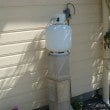 Unsafe securing of smaller gas bottles
Unsafe securing of smaller gas bottles -
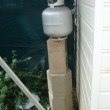 Unsafe securing of smaller gas bottles
Unsafe securing of smaller gas bottles -
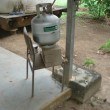 Unsafe securing of smaller gas bottles
Unsafe securing of smaller gas bottles -
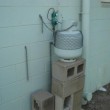 Unsafe securing of smaller gas bottles
Unsafe securing of smaller gas bottles -
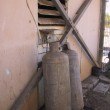 Dangerous installation of gas bottles. No restraint, no solid base and near a venting window.
Dangerous installation of gas bottles. No restraint, no solid base and near a venting window. -
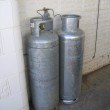 Unsecured gas bottles
Unsecured gas bottles -
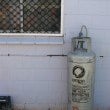 Gas bottle located too close to window
Gas bottle located too close to window -
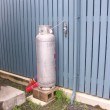 Flexible hoses can split when stretched
Flexible hoses can split when stretched -
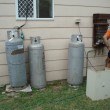 Bottles too close to window and poorly supported
Bottles too close to window and poorly supported -
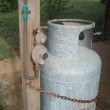 Deterioration of regulator due to exposure to the environment
Deterioration of regulator due to exposure to the environment -
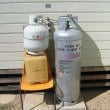 Unsafe securing of smaller gas bottle
Unsafe securing of smaller gas bottle -
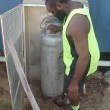 Rising sea level inundates gas bottle enclosure
Rising sea level inundates gas bottle enclosure -
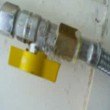 Leaking gas connection
Leaking gas connection -
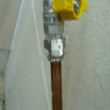 Leaking gas connection
Leaking gas connection -
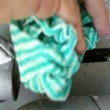 Testing a leaking gas connection
Testing a leaking gas connection
-
Design and Specification
Ensure
- A2.1.1.
gas system is installed to comply with state or territory regulations
- A2.1.2.
gas bottles are safely located away from windows, doors and corners of the building
- A2.1.3.
bottles are accessible for filling or replacing
- A2.1.4.
a platform or base, and a method for securing the bottles, is provided for the bottles
- A2.1.5.
gas regulators and feed lines into the house are secured to the wall and protected from accidental knocks
- A2.1.6.
approved connecting lines and connectors are specified
- A2.1.7.
gas appliances are located in well ventilated areas
- A2.1.8.
appliances are fitted with gas fuses, particularly if they are located near a door or window that could cause a draught.
Real world examples of Solutions
-
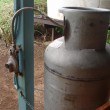 Gas bottles are stamped with important certificate information
Gas bottles are stamped with important certificate information -
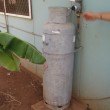 Correct installation of gas bottle
Correct installation of gas bottle -
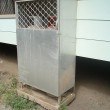 Enclosure for gas bottles
Enclosure for gas bottles -
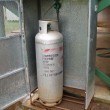 Enclosure for gas bottles
Enclosure for gas bottles -
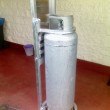 Stand for safely securing large and small gas bottles
Stand for safely securing large and small gas bottles -
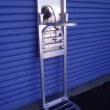 Stand for safely securing large and small gas bottles
Stand for safely securing large and small gas bottles -
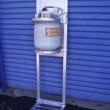 Stand for safely securing large and small gas bottles
Stand for safely securing large and small gas bottles
- A2.1.1.
Quality control
- gas bottles are secure and are located safely

- SKETCH DESIGN
COMPLETED DESIGN & SPECIFICATION
DURING CONSTRUCTION
AT HANDOVER
FINAL COMPLETION
TRADE TEST
- SKETCH DESIGN
- gas bottles are accessible for filling or replacing

- SKETCH DESIGN
COMPLETED DESIGN & SPECIFICATION
DURING CONSTRUCTION
AT HANDOVER
FINAL COMPLETION
- SKETCH DESIGN
- gas appliances are secured to the wall or floor and are stable

- AT HANDOVER
FINAL COMPLETION
TRADE TEST
- AT HANDOVER
- appliances are located in a well ventilated area

- COMPLETED DESIGN & SPECIFICATION
DURING CONSTRUCTION
AT HANDOVER
- COMPLETED DESIGN & SPECIFICATION
- a compliance plate or compliance certificate has been provided by the gas fitter

- AT HANDOVER
FINAL COMPLETION
TRADE TEST
- AT HANDOVER
- the system for leaks, after all appliances and bottles have been installed and are working

- DURING CONSTRUCTION
AT HANDOVER
FINAL COMPLETION
TRADE TEST
- DURING CONSTRUCTION
- all gas system fittings are secure

- DURING CONSTRUCTION
AT HANDOVER
FINAL COMPLETION
TRADE TEST
- DURING CONSTRUCTION
- the operation of all gas appliances all OK.

- DURING CONSTRUCTION
AT HANDOVER
FINAL COMPLETION
TRADE TEST
- DURING CONSTRUCTION
- gas bottles are secure and are located safely
Maintenance
As part of cyclical maintenance, check that:
- the gas system compliance plate is fitted and is current

- Local Maintenance Team, Gas Plumber
- 12 Months
- safety instructions or warnings for the use of gas appliances are located on or near appliances

- Local Maintenance Team, Gas Plumber
- 6 Months
- there are no gas leaks, by putting soapy water on the gas pipes and connections and looking for bubbles

- Local Maintenance Team, Gas Plumber
- 12 Months
- residents are advised not to leave the valve on the gas bottle fully open to prevent the valve sticking and being hard to turn off in an emergency

- Local Maintenance Team
- 6 Months
- residents and housing managers have been provided with information on the operation, maintenance and checking of gas appliances.

- Housing Management, Gas Plumber
- 12 Months
- gas regulators, pipes and bottles are securely fixed

- Local Maintenance Team, Gas Plumber
- 12 Months
- gas stoves, hot water systems and heaters are in good condition and functioning safely.

- Local Maintenance Team, Gas Plumber
- 12 Months
- the gas system compliance plate is fitted and is current
Standard And References
AS/NZS 5601.1:2022 - Gas installations - General installations
Centre for Appropriate Technology Gas fittings, Bush Tech Brief #5, Our Place, Feb 2002, Alice Springs
